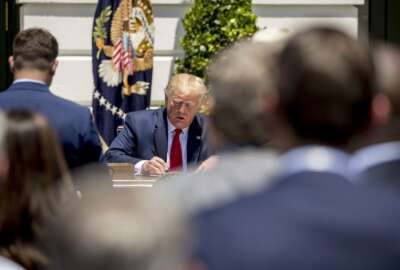
With injunction lifted, OPM tells agencies to implement Trump’s workforce executive orders
The Office of Personnel Management on Friday instructed agencies to begin implementing the president's workforce executive orders on official time, collective...
The Office of Personnel Management has officially told agencies to begin —again — implementing all parts of the president’s workforce executive orders on employee removals, collective bargaining and official time.
The injunction on the president’s workforce executive orders expired Wednesday. The U.S. Court of Appeals subsequently issued a mandate implementing its decision to vacate another decision from a federal district court, which had invalidated nine key provisions of the EOs back in August 2018.
The mandate followed a decision from the appeals court, which last week denied federal employee unions a chance for a rehearing on the merits of the EOs.
“Accordingly, all provisions of these executive orders, including previously enjoined provisions, are in full force and effect and should be implemented consistent with the requirements and guidance contained in the EOs,” OPM Director Dale Cabaniss wrote late Friday afternoon in a new memo to agencies.
OPM’s new guidance contains few other details, but the agency said it does plan to issue further instructions on implementation.
“In the meantime, agencies should immediately review the EOs to ensure that they are fully compliant with all requirements or are taking steps to become compliant with requirements at the soonest feasible opportunity,” Cabaniss wrote.
The Department of Veterans Affairs wasted no time in announcing it would implement the president’s workforce executive orders.
In a statement released earlier Friday afternoon, VA Secretary Robert Wilkie called the decision from the U.S. Court of Appeals a “victory for veterans, taxpayers and VA employees.”
The department, for example, said it plans to limit union use of government office space and other supplies, one of the key provisions in the executive orders.
It specifically cited the Salem VA Medical Center, where union officials occupy 7,500 square feet of space, according to the VA. It named Alma Lee, the president of the American Federation of Government Employees VA Council, in its statement.
“These executive orders will help VA continue to improve by ensuring our employees and resources are focused squarely on serving veterans,” Wilkie said.
The department said it will also continue to reduce official time use by union representatives. It pointed to the 1,048,569 hours union representatives used in fiscal 2016, which cost about $49 million, according to OPM’s latest report on the topic.
The department said that $49 million could be used to employ more than 550 suicide risk management social workers for a year, provide a year of housing to 2,800 homeless veterans or pay for the costs of 355,00 naloxone injection kits, an antidote for opioid overdoses.
VA last fall eliminated official time for Title 38 medical professionals, a decision that AFGE said has already challenged the union’s ability to respond to employee claims and concerns.
The union appeared ready to challenge VA’s plans to implement the president’s workforce executive orders.
“The executive orders themselves clearly state that they do not abrogate existing collective bargaining agreements,” AFGE National President J. David Cox said Friday evening in a statement. “The Department of Veterans Affairs notified us today of its intention to implement provisions of the previously enjoined executive orders following completion of its statutory bargaining obligations. Any attempts by agencies to enforce these provisions outside of the collective bargaining process will be met with immediate legal challenge by the union.”
The department is currently engaged in collective bargaining negotiations with AFGE. VA made a series of proposals in May, which, if implemented, would end labor-management working groups for both parties, change current telework policies and eliminate 28 articles of AFGE’s existing collective bargaining agreement.
Legal battles over the president’s workforce EOs have stretched on for more than a year after a group of more than a dozen unions sued the Trump administration over them last June.
The injunction had been in place since last August, when a federal district court invalidated nine key provisions from Trump’s workforce executive orders. That meant agencies, technically, couldn’t set strict limits on union representatives’ use of official time or ban the organizations from using government office space.
Federal employees unions, however, have said they’ve continued to experience direct impacts of the president’s EOs over the past year while legal battles have continued.
The Trump administration appealed the federal district court’s decision last September.
But in July, the appeals court dismissed the lower court’s decision because, as the three judges argued, the lower court lacked jurisdiction in ruling on the case. The appeals court didn’t weigh in on the legal merits of the president’s workforce executive orders, a point that ultimately fueled the unions’ request for a rehearing.
Throughout these legal battles, the government has maintained that federal employee unions should take their complaints with Trump’s workforce executive orders in specific collective bargaining instances to the Federal Labor Relations Authority.
The FLRA still lacks a Senate-confirmed general counsel, the only person with deciding authority to issue decisions on an unfair labor practice complaint.
Federal employee unions like AFGE and the National Treasury Employees Union said earlier this week they vowed to continue to fight the president’s workforce executive orders.
NTEU National President Tony Reardon said the union would use “whatever means available” to push back.
Copyright © 2025 Federal News Network. All rights reserved. This website is not intended for users located within the European Economic Area.
Nicole Ogrysko is a reporter for Federal News Network focusing on the federal workforce and federal pay and benefits.
Follow @nogryskoWFED






